Content of the article

Today, advertising medical services is one of the most challenging and yet necessary areas of online marketing. On the one hand, an effective advertising campaign can significantly increase the flow of patients, increase the clinic’s recognition, and strengthen the brand’s reputation. On the other hand, medical topics belong to categories with an increased risk of blocking on advertising platforms and strict regulation by government agencies. Violation of platform rules or national legislation can lead to rejection of ads, account blocking, financial penalties, and loss of patient trust.
In this article, we’ll take a closer look at how to advertise healthcare services without violations, combining the requirements of advertising platforms, legislation, and ethical standards.
Rules for effective advertising of medical services
Failure to comply with the rules of advertising platforms, legal requirements, or ethical standards can lead to ad blocking, fines, or loss of patient trust. On the contrary, adherence to them helps to create advertising that is not only effective but also safe for business, increasing the level of audience trust and saving the budget.
Texts and wording
When creating advertising messages, it is important to avoid absolute guarantees and excessive promises. Platforms quickly react to trigger words and mentions of prescription drugs without appropriate confirmation.
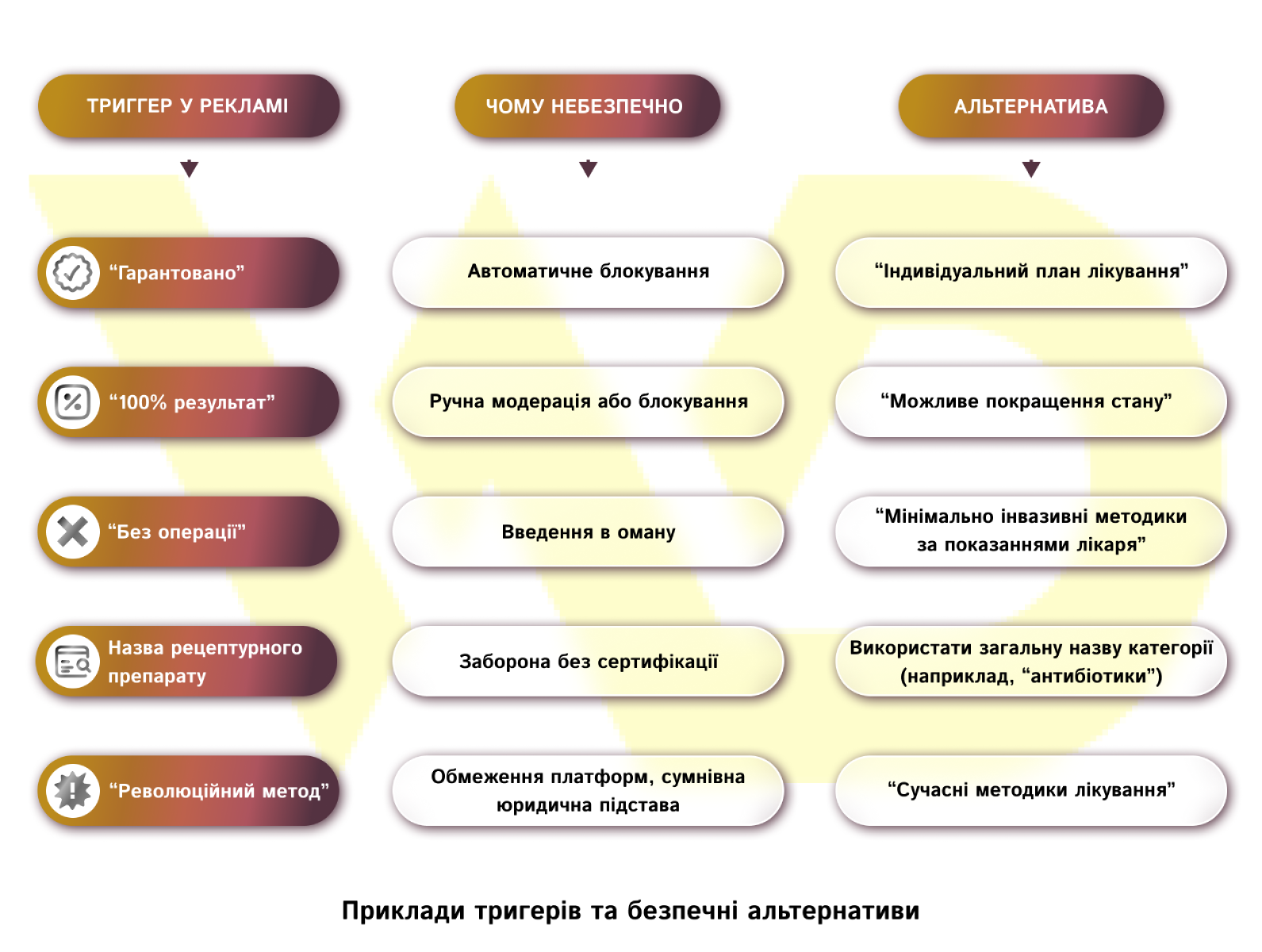
Visual standards
Images in healthcare advertising are subject to strict restrictions. Using photos of patients without consent or showing potentially sensitive scenes can lead to sanctions or ad blocking, so give preference to photos of the team, clinic, equipment, or abstract illustrations and infographics. If you can’t do without a photo of a patient, then written consent and, if necessary, face masking are required. Make infographics and graphic materials concise and informative, without exaggeration or «scary» images, and use restrained, professional colors – white, blue, light green – to build trust.
Landing pages and data collection forms
Medical data is sensitive personal data that is subject to a special protection regime under the Law of Ukraine «On Personal Data Protection« and the requirements of the Ministry of Health. Incorrect collection or processing of data increases the risk of complaints, inspections, and financial penalties. Therefore, collect only the minimum necessary information: name, contacts, main symptoms or needs. In addition, encrypt and restrict access to sensitive fields on the backend, and place links to the privacy policy and an explanation of how the data is processed on the form pages.
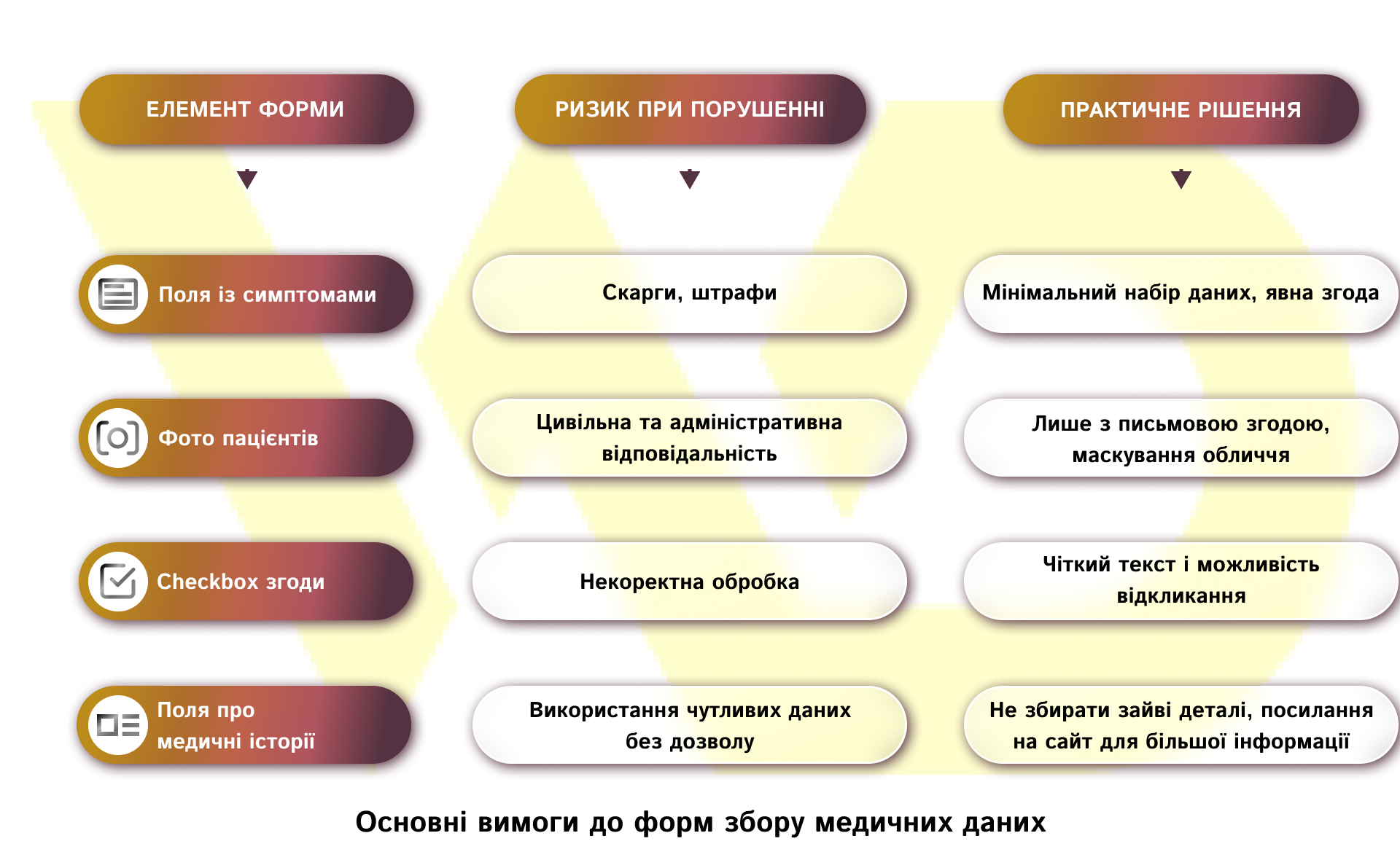
Compliance with legislation and platform rules
The combination of platform policies and national legislation should be laid down at the stage of creating creatives – this avoids deviations and speeds up moderation. Before launching a campaign, check the Google and Meta sections dedicated to «Healthcare and medicines» and integrate the relevant legal requirements of Ukraine directly into the texts of landing pages: correct wording, links to methodologies, and instructions on restrictions on prescription drug advertising. If possible, upload scans of licenses and certificates to your advertising account, as this greatly simplifies the appeal process in case of rejection of ads. Pay special attention to the rules of personal data processing and avoidance of targeting by sensitive features.
Compliance with these rules allows advertisers to effectively create medical advertising campaigns, minimizing the risk of blocking, financial penalties, and reputational damage.
What types of online advertising are suitable for medical services
Advertising of medical services is characterized by high requirements for information accuracy and ethical communication. The choice of channel and format determines not only the effectiveness of the campaign but also its safety for the advertiser.
Contextual advertising
Contextual advertising, such as Google Ads or Bing Ads, shows ads to users who are actively looking for medical services. It is one of the most targeted forms of advertising.
The advantages include
- high relevance of search queries;
- the possibility of detailed geographic and thematic targeting;
- quick testing of different texts and keywords, conversion analysis.
When creating contextual advertising, you should follow the rules we have already discussed above.
For contextual advertising, it is useful to use remarketing, which means repeatedly showing ads to users who have already been interested in your services, which increases the likelihood of conversion.
Show your clinic to those who are looking for help.
Thanks to professionally configured contextual advertising from WEDEX, you will receive a stream of targeted inquiries and increased brand trust.
Display advertising and banners
Display advertising increases brand awareness and allows you to effectively showcase your clinic’s services. It is especially useful for launching new procedures, special promotions, or building trust in experts.
To increase the effectiveness of display advertising, it is recommended to test different banner formats – static, animated, or interactive – to determine which ones attract attention and stimulate clicks better. In addition, each banner should include a brief description of the service and a button to go to the landing page, which will help the user quickly get additional information and increase conversion. But it is important that the signature and CTA (Call to Action) are ethical and comply with the current legislation.
Social media
Social media opens up the possibility of engaging the audience through videos, carousels, interactive posts, and stories. They allow targeting by age, place of residence, interests, and user behavior.
Advantages of social media advertising:
- the ability to quickly test different creatives;
- building trust and interaction with potential patients;
- effective for branding and increasing clinic awareness.
When advertising healthcare services on social media, keep in mind that platforms limit the display of ads for certain categories, especially when it comes to prescription drugs and sensitive areas such as reproductive health or psychiatry. To avoid blocking, be sure to add links to landing pages with legally correct texts explaining the service and terms of service.
Social networks work well for creating a community around a brand, which increases loyalty and trust in a clinic or an individual specialist.
E-mail and SMS marketing
These channels allow you to communicate directly with patients who have agreed to receive information. They are effective for appointment reminders, recommendations based on examination history, and customer retention.
When using email and SMS marketing, it is important to collect only the minimum necessary data and provide a quick unsubscribe option. Personalization of messages, such as including the patient’s name or details of their examinations, increases the effectiveness of communication.
Video advertising
Video advertising on YouTube or other platforms allows you to demonstrate procedures, equipment, and doctors’ work in detail. It is effective in building trust and explaining complex services. When creating such ads, use professional editing and infographics for clarity.
Video integrates well with other channels, such as banners, social media, or contextual advertising, to enhance the effect.
Thus, we can see that each online advertising channel has its own features, advantages, and limitations. You should choose the ones that are right for your business, not all at once. For a better understanding, let’s look at real examples of healthcare advertising that demonstrate how these principles are applied in practice and allow us to see what works in the Ukrainian and international context.
Examples of healthcare advertising
Looking at examples of real-life advertising campaigns, you can see how compliance with the rules ensures high efficiency of healthcare advertising. Let’s start with offline advertising of medical services.
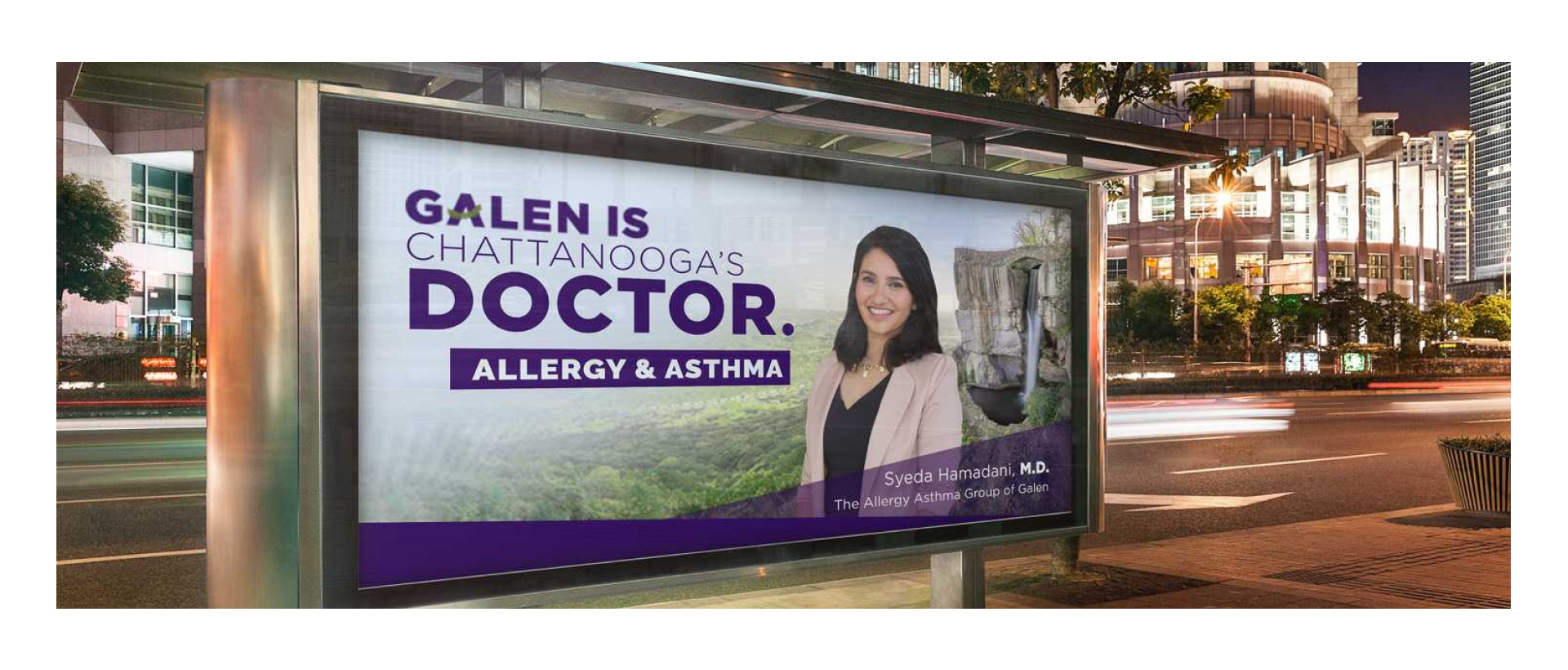
The Galen MD clinic’s billboard demonstrates a format that combines modern, professional design with a clear message that conveys trust. The emphasis is on experienced medical staff, logo and a short slogan that is easily perceived by drivers and pedestrians.

A medical billboard with a visualization of a body part or anatomy shows how to use strong imagery without being overly dramatic: a body part (such as an arm or heart) is presented in a clean, modern style that attracts attention but does not shock.
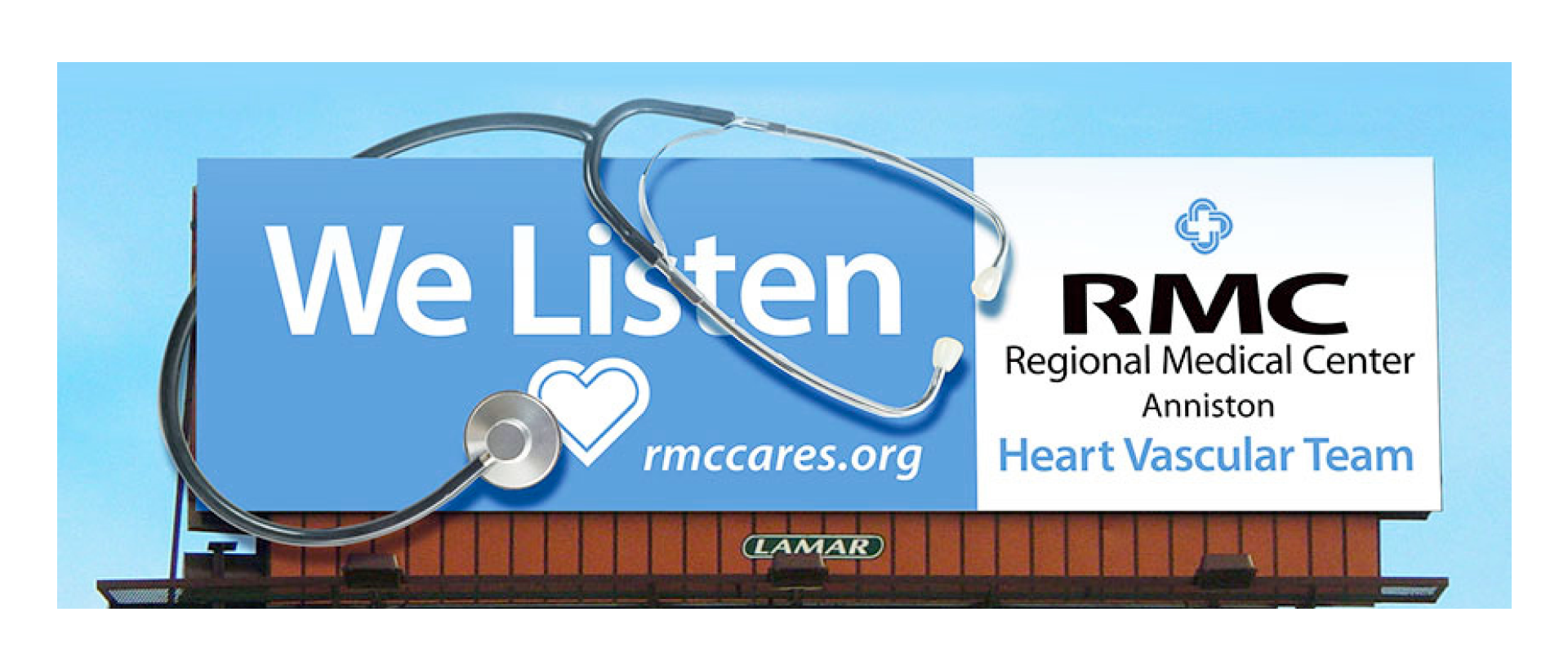
The billboard of the RMC Medical Center is designed in a minimalist style with an emphasis on the main message «We Listen». The use of a stethoscope as a visual element emphasizes the medical theme and creates an association with attentiveness to patients. The design is in blue and white, which symbolizes purity and trust, and the logo, clinic name, and website link provide recognition and quick access.
Of course, there is also a lot of medical advertising online.
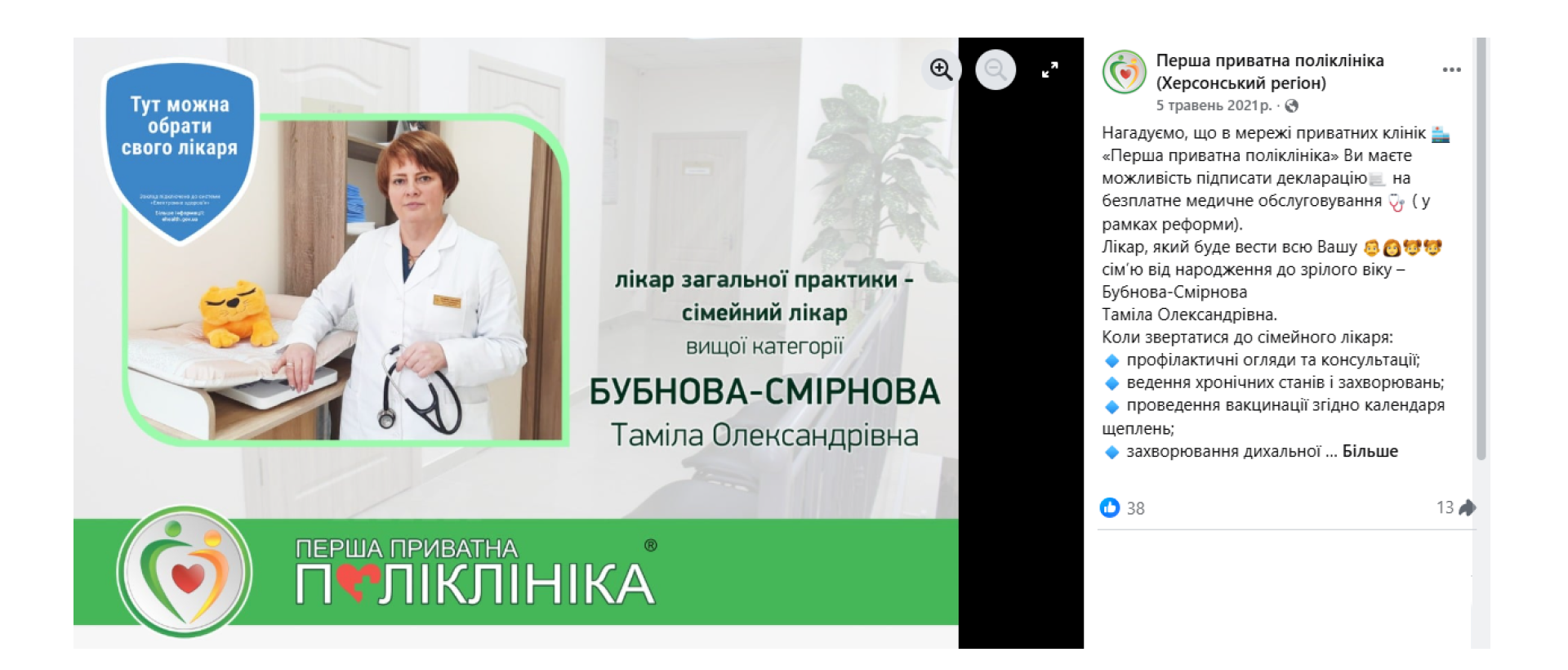
The Facebook ad for a family doctor at the First Private Clinic is made in a restrained medical style with a combination of green and white colors that are associated with care, trust, and professionalism. The photo of a doctor in a white coat creates a sense of safety and competence. Visual emphasis is placed on the slogan «Here you can choose your doctor», which emphasizes the main message of the campaign – the opportunity to sign a declaration for free service. The clinic’s logo and clearly written contacts build recognition and trust.
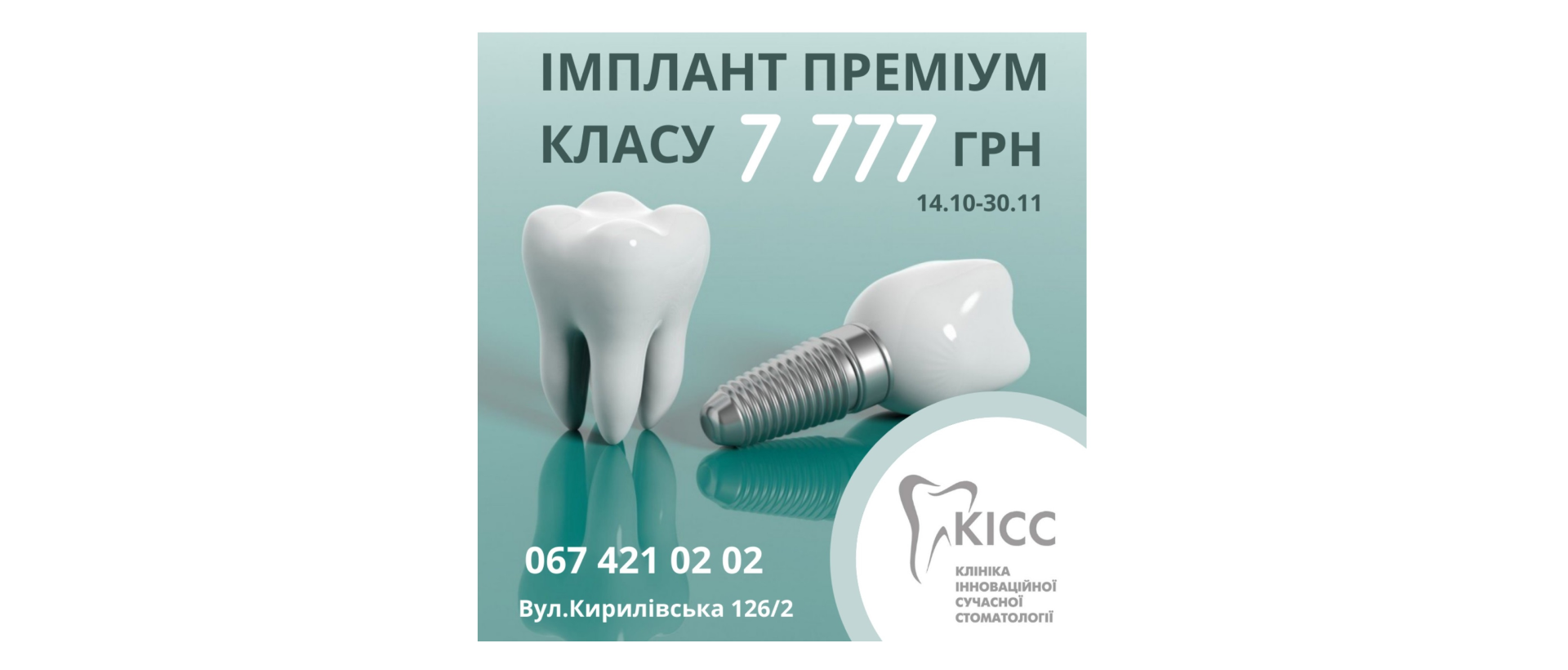
The online banner of the clinic of innovative modern dentistry is built in a minimalist style with an emphasis on the main offer – «Premium implant for 7,777 UAH». We used 3D visualization of the tooth and implant, which clearly illustrates the service without causing disgust. The light turquoise background reinforces associations with sterility and modern technology. The clinic’s logo, address and phone number add information to the ad and provide quick contact.

The advertising banner on the website of the Veselka Medical Center and on social media is based on a bright, friendly identity. The main message – «Checkup for a healthy person!» – is presented in large print, combined with a motivating call «Take care of yourself and make an appointment today.» The use of photos of smiling young people creates an atmosphere of optimism and accessibility of the service. The logo in the form of a bird and warm colors (yellow, orange) create a positive emotional background and ease of perception.
Key tools for promoting medical services online
For healthcare advertising to work systematically and safely, a single creative or a single campaign is not enough – you need an infrastructure. At the center of this infrastructure is a website and a set of tools that together build trust, drive relevant traffic, and allow you to measure business results.
Website
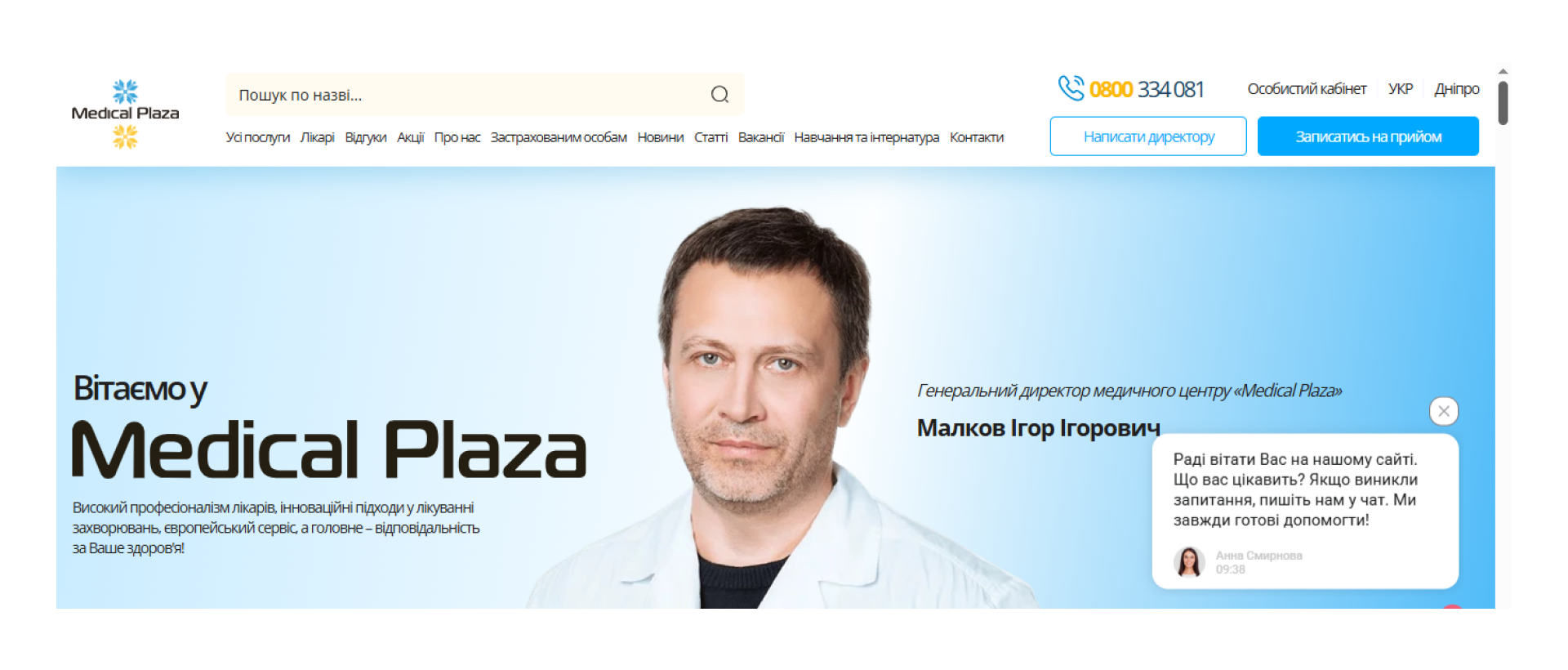
A clinic website is the first and main source of trust for a patient. It should be fast, clear, and meet the expectations of the audience.
Any medical website must have
- a home page with a clear USP (what exactly you do better than others) and visible contacts;
- service pages: for each service, a separate landing page with a description, indications and contraindications, expected stages of treatment, duration, and payment options
- doctors’ pages with photos, qualifications, education, reviews, and certificates. This is an important part of E-E-A-T (expertise – experience – authoritativeness – trustworthiness);
- contact information and a map with address, working hours, phone numbers (a «call» button for mobile phones);
- a registration form with a minimum set of fields and explicit consent to the processing of medical data;
- a section of reviews or cases (with written consent of patients) and certificates and licenses in a prominent place;
- a blog or section with expert content: FAQ, articles, videos, infographics.

SEO and local promotion
SEO for a medical business is a source of cheaper, stable traffic that includes not only texts but also is a system of trust.
The main directions:
- Technical SEO: sitemap, robots.txt, logic of canonical URLs, speed, mobility;
- On-page: key pages with optimized titles, H1, semantics (LSI), FAQ blocks;
- Content strategy: articles on such topics as «what kind of procedure is it», «when you need a consultation», «preparation for the examination», case studies with a description of the stages;
- E-E-A-T: signatures of articles by doctors, links to sources, certificates – all this increases the ranking in the medical niche;
- local promotion: optimization of Google Business Profile and Google Maps, filling out a card (photos, services, schedule), working with reviews (responding to reviews, collecting positive ones from real patients).

Content marketing
Content is a tool of trust and a channel for solving patient problems before contacting the clinic.
Among the recommended formats:
- Educational articles (clinical facts, preparation, contraindications);
- FAQ on landing pages: answers to search queries in the form of short blocks;
- video demonstrations of processes, interviews with doctors, virtual tours of the clinic;
- infographics: simple checklists on how to prepare for surgery and recovery;
- E-mail series for patients after the appointment: what to expect, preparing for the visit, recommendations after the procedure.

Paid tools: PPC, remarketing, native advertising
Paid tools provide a quick start to patient flow, but require customization to meet the limitations.
What to use:
- Google Search Ads for lead generation by «hot» queries (for example, «dental implantation in Kyiv»). You need correct headlines and a landing page;
- remarketing – returning visitors who have seen the service page;
- social media: SMM and targeting for branding and audience engagement. For sensitive topics, you should use more cautious creatives;
- native advertising: articles and stories in specialized medical or local media to build trust;
- affiliate channels: record aggregators, medical services marketplaces (but you need to carefully read the terms and conditions and the commission).
Don’t forget about Google/Meta certification if you are promoting prescription drugs or telemedicine – check the rules before launching a campaign.
Reputation and social proof
Reputation is the invisible capital of a clinic: reviews, case studies, and media mentions accelerate patient decisions and increase the conversion of advertising campaigns.
Recommended practices:
- systematic collection of reviews immediately after the visit (automatic SMS/Email with a link to Google, a review page, or an internal form);
- prompt response to feedback: standardized templates for thanking for positive feedback and a scenario for a constructive response to negative feedback (with an offer to resolve the issue privately);
- publishing cases only with the written consent of the patient or in an anonymized form. Keep technical proof of consent (ID/date);
- Visible placement of certificates, licenses and memberships of professional associations on the website and in promotional materials (in the format allowed by the rules of the association);
- media relations: expert commentaries, PR articles and thematic materials in specialized media to enhance credibility and SEO;
- monitoring of mentions and protection against fakes (Google Alerts, social monitoring tools) + escalation procedure for systemic attacks;
- ethical use of testimonials in advertising, i.e. only with the written consent of the author and without legally problematic statements (no guarantees of treatment).

Analytics and tracking results
Analytics is the basis for decision-making: without properly configured tools, it is impossible to understand which campaigns bring quality leads and where to optimize the budget.
The main tools that should be used:
- GA4 + server-based GTM (for more reliable tracking);
- UTM tags for each campaign and/or creative;
- Conversion tracking: CRM recordings, calls, online recordings;
- attribution: set up reports by source or channel, patient LTV and CAC;
- Dashboard for business owners: CPA, CPL, conversion to record, average check, patient retention rate.
Start with the minimum required KPIs: number of appointments, CPL, and post-appointment bounce rate. Gradually add quality metrics: appointment-to-payment conversion, LTV, repeat visits. When implementing, do not forget about the protection of personal data, i.e. minimize the transfer of sensitive information to analytics, document the grounds for processing, and use encryption where necessary.
CRM, automation, and workflows
Automation tools turn traffic into a predictable, manageable flow of patients.
Essentials:
- CRM with medical logic: notes, final statuses (new – recorded – came – canceled), doctor’s calendar;
- automatic triggers: appointment confirmation, SMS or Email reminders (48/24/2 hours before the visit), welcome series for new patients;
- integration with PPC or Forms: direct flow of leads for instant processing and prioritization;
- templates and processing scripts: operator scripts, answers to common questions;
- Appeals log: a log of appeals and requests from platforms with all documents and results;
- SLA monitoring: those responsible for channels, time SLAs (time to first contact, confirmation);
- CRM analytics: CPL, % of processed leads, time to contact, conversion to appointment and payment, synchronization with GA4 and dashboard;
- data security: encryption, access control by roles, access log, deletion and anonymization procedure;
- QA and testing: regular checks of the chain: ad – form – CRM – trigger;
- backup scenarios: failure plan (temporary form, manual routing, message templates).
The priority is fast lead processing (time to first contact) and at the same time strict compliance with personal data protection requirements. It is the combination of speed and security that gives the best conversion rate and minimizes risks.
Data security and legal compliance
Personal data protection is not an option, but a requirement. Even marketing tools should include it as a standard.
What to include:
- clear privacy policies, a consent mechanism for data processing;
- encryption of data in the database, restriction of employee access;
- procedures for deleting and anonymizing data at the patient’s request;
- in the case of telemedicine, use certified platforms that provide secure communication channels.
Designate a data protection officer, sign data processing agreements with all vendors, and keep logs of data access and transfers. This will make it easier to prove compliance during audits and speed up incident response. Regular internal audits, incident response testing, and staff training significantly reduce the risk of a breach and the financial and reputational consequences.
The availability and coordinated use of these tools allows you to not only launch effective advertising campaigns, but also make them sustainable – with a low risk of blocking, clear cost control, and measurable business results. In the next section, we’ll move on to the practice of setting up targeting and audiences in a way that minimizes risks while maintaining campaign conversion rates.
Targeting and setting up ads without violations
An error in setting up an audience can quickly turn effective communication into ad blocking or legal risk. Therefore, let’s consider practical rules that will reduce risks and maintain conversion rates.
- Demographics and geography.
Focus mainly on age groups, gender, and geographic location (city, district, radius of 5-25 km). Specify demographics only where they are relevant to the service, for example, 25-55 years old for certain dermatological procedures. Geo-targeting should be adjusted to the clinic’s working hours and service radius to increase the likelihood of timely contact.
- Exclusion of sensitive categories.
Create exclusion lists for topics and audiences related to mental health, reproductive issues, addictions, and other sensitive topics. Do not use form fields with diagnoses or symptoms in your targeting. Ensure that you have explicit consent to the processing of sensitive data if it is collected.
- Look-alike and remarketing is the right approach.
To build similar audiences, use technical and behavioral signals (visits to service pages, completed forms, payments), but never lists with diagnoses. Set up remarketing to broader service pages or categories, control the frequency of impressions, and avoid repeatedly sharing content that directly indicates a disease.
- Customize ads and campaigns.
Set age restrictions for sensitive areas and limit the display schedule so that ads run during hours when it is possible to process the lead quickly. Maintain an up-to-date negative list in contextual campaigns, test texts and visuals for «cleanliness» in terms of platform policies, and always keep links to landing pages with licenses and contacts.
- Budgeting and bid strategy.
Distribute the budget between hot search queries (higher CPL but higher conversion), remarketing (lower CPL), and tests (10-15% of the budget). For priority keywords, use controlled strategies (Manual CPC or Target CPA with an upper limit), for remarketing, use more aggressive bids due to the lower cost of the lead.
- Monitoring and log of appeals.
Set up alerts for ad rejections and keep a general appeal log with all materials: Ad ID, screenshots, landing page, documents. Designate a person responsible for communication with the platform and an algorithm of actions: creative editing – re-moderation – appeal with a package of documents.
- Typical mistakes and their consequences.
The most common mistakes are disease-based targeting, submitting text fields with symptoms, lack of negative words, and delayed response to rejections. The consequences are rejected ads, wasted budget, and the risk of account blocking. Therefore, test all changes on small budgets and document the results.

Healthcare advertising is not so much about quick sales as it is about trust and compliance. Only a combination of marketing, law, and ethics ensures a steady flow of patients and business sustainability.


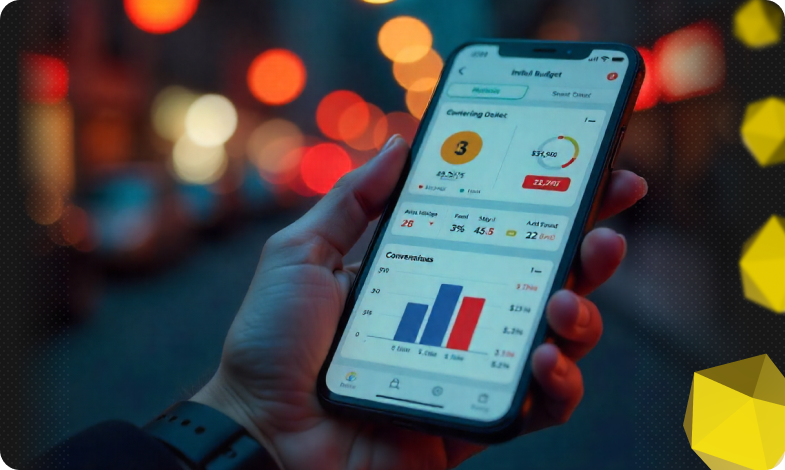



 09/10/2025
09/10/2025  1206
1206


